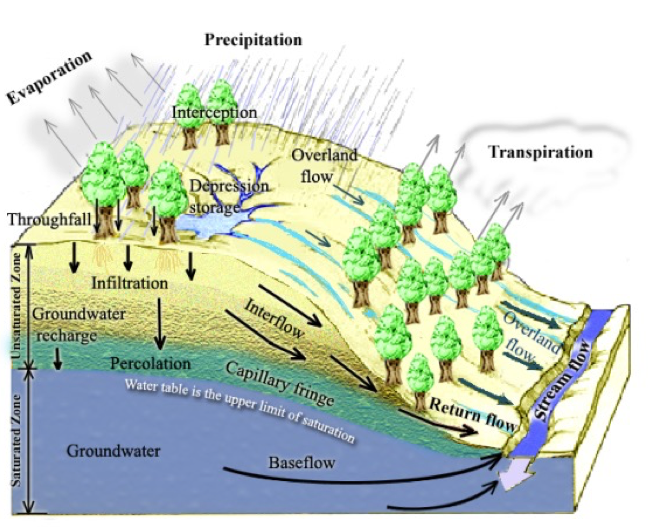Quantifying Runoff Generation
HydroLearn

Problem Statement
Flash flooding is a hazard in many parts of the world. In south Louisiana, the terrain is particularly flat with minimal natural slope to support efficient drainage. Flash flooding is common in urban areas where runoff from rainfall quickly accumulates in coulees and cannot drain fast enough. A flash flood is a sudden and rapid rise in stream water depth resulting from heavy, localized rainfall. With a growing population, developing neighborhoods in terrain susceptible to flash floods has become more common and therefore increased the potential for damage to private property and public infrastructure.
Hydrologists are frequently required to design flood protection infrastructure to protect people and property from the impacts of flash flooding. An important hydrologic question in designing for flood protection is: How much streamflow occurs in a river in response to a given amount of rainfall? To answer this question we need to know where water goes when it rains, how long does water reside in a watershed, and what pathway does water take to the stream channel. This module addresses these questions and also looks at how much runoff is generated from surface water input comprised of rainfall.
Module Overview
You will learn to implement the Green-Ampt method for runoff generation which depends on watershed and soil properties, which will also be quantified.
Topics Covered
Runoff and Infiltration, Modeling Using HEC-HMS
Pre-requisites
This module is one of three spin-offs from the "Hydrologic Design of a Storm Detention Basin: Beau Bassin Watershed, LA (HL402-2)" module. While each of the following mini-modules have been created as a stand-alone learning experience, we recommend implementing these modules in the following order for a comprehensive coverage of these topics:
1) Development of Design Storms (HL414)
2) Quantifying Runoff Generation (HL413)
3) Developing Storm Inflow and Outflow Hydrographs (HL416)
Learning Objectives
At the end of this case study, you should be able to describe and implement the steps involved in: quantifying design storm runoff and infiltration depths manually, producing runoff and infiltration depths and distributions through HEC-HMS software
This will be accomplished through activities within each section. Results from each activity will be recorded in specified results templates. The results templates for each activity can be found at the beginning of each activity. The results templates are organized such that results from one activity can easily be used in successive activities.
Course Authors
Emad Habib, PhD, PE
University of Louisiana at Lafayette. Contact: habib@louisiana.edu
Olivia LaHaye, Graduate Research Assistant
University of Louisiana at Lafayette. Contact: C00121316@louisiana.edu
Target Audience
Junior/Senior Hydrology and Water Resources Engineering Courses
Tools Needed
Computer with access to Internet, Excel, and free HEC-HMS software
Course Sharing and Adaptation
This course is available for export by clicking the "Export Link" at the top right of this page. If you are an Instructor seeking the answer keys, please contact the course creators using your official University email account.
Expected Total Hours
A student could expect to complete this module with approximately 6 work hours.
